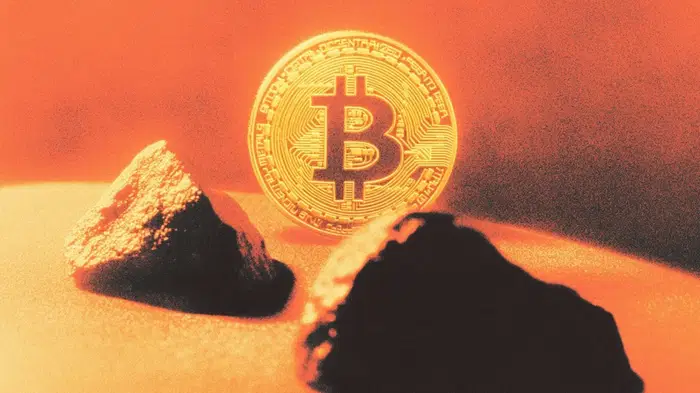
Subscribe to Bankless or sign in
For ![]() Bitcoin holders, 2025 has been a tough pill to swallow.
Bitcoin holders, 2025 has been a tough pill to swallow.
While gold ripped to $4.4K per ounce, a 60% gain at peak year-to-date (YTD), all while hitting new all-time highs on dozens of occasions, Bitcoin has comparatively limped along with just 15% YTD gains. For an asset marketed as "digital gold," watching the original outperform by more than 3x can sting.
If Bitcoin is supposed to be a superior store of value, why is it getting left in the dust during what looks like a classic safe-haven rally?
Many believe gold can be used as a leading indicator for Bitcoin's moves, with a historical lag of 70 to 100 days. In other words, gold's current surge might not signal dysfunction for Bitcoin's narrative. It could be a precursor to what comes next. Others believe this surge actually signals the end of an asset cycle overall, marking a clear stop for risk asset appreciation.
The question, of course, is which one this latest rally represents. To figure that out, we need to understand what's driving gold right now, what similar rallies have meant historically, and how these two assets actually function in a portfolio. 👇
What's Going on with Gold?
Gold's relentless 2025 performance can be attributed to unprecedented, and equally relentless, central bank buying, driven by a cocktail of inflation concerns, geopolitical tension, and a fundamental shift in how central banks think about reserves.
Gold purchased by central banks had their second largest Q1 on record this year. Poland added 67 tonnes amid the Ukraine conflict. Turkey picked up 19.5 tonnes as its currency weakens. China continues to quietly accumulate amid its tensions with the U.S., swapping out its stash of U.S. Treasuries, while, in Shanghai, gold futures volumes have tripled since early 2024, as investors pile in, alongside the central bank, amid economic uncertainty.
Gold Warrants on the Shanghai futures exchange have nearly doubled since this chart posted a month ago. Up 25x since the beginning if the year.
—
If anyone asks the question "who is buying gold?"
Show them the updated chart and say "China."
---
What is a Gold Warrant
A gold… https://t.co/NFORYepdmX pic.twitter.com/Q0DTth6x0LJim Bianco (@biancoresearch) October 20, 2025
Gold is increasingly replacing U.S. Treasuries as the "riskless" asset in global portfolios. With mounting U.S. debt and political dysfunction, central banks are diversifying. Some reports suggest gold has even flipped Treasuries to become the number one central bank reserve asset globally, though this remains disputed.
Why? Gold doesn't carry counterparty risk and can't be printed or devalued by central bank decisions. In an era where trust in institutions is eroding, that matters.
Still, gold is showing signs of being clearly overbought, especially given the volatility of the past few days. Parabolic moves like this rarely end smoothly. Which raises the question: what does a gold rally of this magnitude actually signal?
What Have Gold Rallies Meant in the Past?
To understand what gold's current surge might mean for Bitcoin, it helps to look at what similar rallies have signaled historically. The answer isn't simple. Sometimes gold's parabolic moves have preceded major crises. Other times, they've set the stage for broader risk-on rallies, with Bitcoin following months later.
The Bear Case: Late-Cycle Behavior
Gold surges often coincide with late-cycle uncertainty. From 2007 to 2008, gold spiked as the subprime crisis unraveled. That rally started before the crash, as investors positioned for what was coming. Similarly, in 1999 and 2000, gold shot up ~34% as the dot-com bubble burst and recession followed.
Both @2xdog & @JapanDeepValue1 have educated me about gold spiking before the 2000 and 2008 crashes. When everything's elevated, where else do you go? And so you create your own bubble in the escape hatch. pic.twitter.com/xkMLHB7QI5
—Chris Burniske (@cburniske) October 17, 2025
While, in many respects, today is different from these past periods, there certainly is a parallel level of unease in the market against the backdrop of geopolitical tension and economic uncertainty. Further, as we well know in crypto, steep climbs tend to end in sharp corrections. Gold has experienced this in the past, for example in 2010 and 2011 when the asset surged 70% before collapsing 45%.
The Golden Age is here…https://t.co/dGVNGD3IlO pic.twitter.com/yWIwDl7gGm
— Balaji (@balajis) October 20, 2025
But is this really a late-cycle warning? Maybe. Gold similarly rallied during 2020's COVID crisis, but the 2020 surge led to recovery, not prolonged downturn. This time, central banks are accumulating over 1K tonnes per year amid a structural shift away from dollar reserves. That should not be ignored.
The Bull Case: Gold as a Leading Indicator for Bitcoin
Evidence suggests that, when gold breaks out, Bitcoin has followed, usually with a lag of 70-100 days.
The clearest example is 2020. Gold surged to $2,075 amid pandemic uncertainty. About 85 days later, Bitcoin began its climb from $5K to $10K, then exploded 590% to hit $64K by early 2021. Gold moved first as a safe-haven play, then capital rotated into Bitcoin as risk appetite returned. A similar situation happened last August, with gold ripping to new all time highs while Bitcoin lagged. This was chronicled in an article published then by Coin Market Cap titled “Gold Hits All-time Highs, Why Is Bitcoin Lagging?” In its wake, as we know, Bitcoin lagged for about two months before surging come November.
If the historical pattern holds, gold's rally could be setting up Bitcoin's next leg higher. Once gold peaks or shows exhaustion, capital could flow into Bitcoin as investors shift from defensive positioning to offensive plays.
Gold doesn't need to stop rising for Bitcoin to run. These assets often diverge during transitions. The key is recognizing that gold moves first in debasement trades, and Bitcoin follows once the narrative crystallizes. So, while past performance doesn't dictate future results, know that gold’s run is not a death sentence for Bitcoin.
Things to Consider
Whether you believe gold's rally signals late-cycle risk or sets up Bitcoin's next move, it's worth understanding what these assets actually do in a portfolio.
Ray Dalio has long argued that gold is a preservation tool, pointing out that it maintains purchasing power in a world where 80% of currencies have disappeared or been severely devalued since 1750. Gold can't be printed or manipulated by central banks. It's the ultimate hedge against currency collapse.
Thus, he recommends allocating to gold, not because it outperforms, but because it provides an anchor when other assets fail.
— Ray Dalio (@RayDalio) October 17, 2025
Bitcoin, on the other hand, is functioning as a growth store of value. The DeFi Report's Bitcoin versus Gold analysis makes this explicit:
- A portfolio with 5% gold and 95% S&P 500 returned 152% since 2018
- A portfolio with 5% Bitcoin and 95% S&P 500 returned 199%
- At 10% allocations, gold delivered 155% while Bitcoin hit 253%
Another way of explaining it is that gold has had millennia to realize its value, as an asset that provides stability during periods of uncertainty. Bitcoin, still growing into this, behaves with more volatility but significantly outperforms. If your goal is wealth preservation in uncertain times, gold makes sense. If you're willing to stomach volatility (though recently it's been a bit more boring) for outsized returns, Bitcoin still remains the better bet.
So, while Bitcoin holders might feel frustrated for now watching gold gains, if history repeats itself, that frustration could be short-lived.




